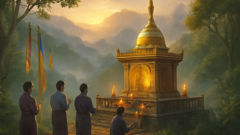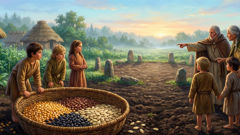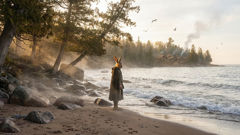Introduction
Myanmar, a land where golden pagodas pierce the horizon and ancient forests whisper forgotten secrets, is alive with spirits. Along winding riverbanks, through bustling markets, and in the silent shadows of mountainous jungles, the Nats—the revered spirits of Myanmar—move unseen but always felt. They are as much a part of daily life as the monsoon rains and the scent of jasmine drifting through village windows at dusk. In Myanmar’s vibrant spiritual tapestry, Nats stand at the crossroads of nature, myth, and memory. These spirits are not distant deities, but ever-present beings who dwell in banyan trees, haunted ruins, or atop the sacred Mount Popa. They are both feared and cherished, invoked for protection, luck, or guidance, and appeased through elaborate rituals and colorful festivals. Some Nats are ancient guardians of wild places; others are tragic mortals who died untimely, violent deaths, their stories woven with sorrow, resilience, and transformation. Offerings of bananas, coconuts, and flowers line village shrines, as worshippers whisper prayers to the unseen world, maintaining a delicate balance between humans and spirits. The Nats shape every layer of Myanmar’s culture, from the rhythm of rural life to the pageantry of national celebrations. Through their tales, one hears the voice of the country—at once mystical, compassionate, and wise. To journey into the world of the Nats is to wander through Myanmar’s living folklore, where every hill and riverbank may conceal a legend and every day holds the possibility of encountering the divine.
Guardians of Land and Spirit: The Ancient Nats
The forests and mountains of Myanmar are older than memory, their roots entangled with stories that echo back through centuries. It is in these wild places that the oldest Nats are said to dwell. Unlike human spirits or legendary heroes, these primordial beings belong to the land itself—manifestations of the mighty trees, rushing rivers, and wind-carved cliffs that define Myanmar’s landscape. The villagers call them ‘Yokkha Nat’—guardians who shield the boundaries between the human and spirit worlds.

In the highlands of Shan State, elders recall how the wind would shift before a storm, carrying with it the laughter or warning cries of Nat spirits. Farmers leave neat piles of rice at the foot of banyan trees, hoping for a bountiful harvest. Children are cautioned not to disturb old fig trees or whisper near sacred springs, lest they anger the Nat within. Such reverence is not born out of superstition, but a lived understanding: the Nats reward respect with protection, but can unleash misfortune if dishonored.
Among these ancient spirits is Shwe Saga, the golden Nat of the Irrawaddy. He is said to rise from the river’s depths on moonlit nights, his face aglow with gold leaf, to oversee the flow of trade and the fate of those who cross the waters. When fishermen see eddies spinning unexpectedly, they cast offerings of rice and betel into the current, whispering their thanks to Shwe Saga for safe passage.
Yet not all Nats are gentle. Deep in the forests, travelers speak of Maung Tint De—the Lord of the Great Mountain. Before he became a Nat, Tint De was a blacksmith whose tragic tale would shape the very nature of Myanmar’s spiritual beliefs. He and his sister Shwe Nabay suffered under a jealous king, their wrongful deaths echoing in the cries of orphans and the wails of widows. The land itself seemed to mourn, and when storms battered the villages, people believed it was the blacksmith’s wrath unleashed. In time, shrines to Maung Tint De and Shwe Nabay rose at crossroads and hilltops, places where villagers sought both forgiveness and strength.
There are stories of Nats who protect villages from plague, those who command rain, and others who dwell in lonely caves, preferring solitude to worship. For every region, there is a Nat whose tale is told at night around the fire, their presence acknowledged in songs, rituals, and festivals. Over time, these spirits became inseparable from Myanmar’s geography—every river bend and ancient fig tree alive with memory and myth.
Deified Mortals: Tragedy, Heroism, and the Rise of the Thirty-Seven Nats
Beyond the ancient guardians of nature, Myanmar’s spiritual pantheon is crowned by the Thirty-Seven Official Nats—mortals whose lives were marked by tragedy, heroism, or both. Their stories ripple through generations, bridging history with myth and providing guidance for those seeking solace or justice. Each Nat began as a living person: a prince betrayed by ambition, a queen wronged by fate, a blacksmith whose courage became legend. Their deaths were almost always violent, often unjust, and their spirits lingered to shape the destiny of the living.
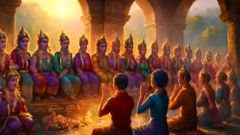
Chief among them is Thagya Min, the King of the Nats, whose origins lie in the mists of Buddhist cosmology. Thagya Min is not a vengeful ghost, but a benevolent sovereign, guiding the other Nats and ensuring harmony between humans and spirits. On the festival of Thingyan—the Burmese New Year—Thagya Min is said to descend from his celestial palace to observe humanity, leaving a golden book to record good deeds and a black book for misdeeds. Children are told to behave, for Thagya Min’s judgment will shape their luck in the coming year.
Yet many of the Thirty-Seven began life in suffering. Take Min Mahagiri, once Maung Tint De, whose strength and skill made him both hero and threat. Betrayed by the king and burned alive with his sister, his spirit raged until villagers erected shrines in his honor, pleading for mercy and protection. Even today, on Mount Popa—the spiritual heartland of Nat worship—pilgrims climb hundreds of steps to offer coconuts and incense to Min Mahagiri and Shwe Nabay, whose statues watch over the countryside with serene, forgiving faces.
Other Nats are remembered for their wisdom or sacrifice. Shwe Myetnha, the Lady with the Golden Face, was known for her kindness and beauty, envied by a jealous rival who conspired to destroy her. Though her end was tragic, her spirit became a beacon of hope for those who suffer in silence. At her shrines, women seeking justice or courage tie threads of gold to her effigy, believing she will intercede on their behalf.
The stories of the Thirty-Seven are not only tales of death, but of transformation. Each Nat found new purpose as a guardian or guide, their memory preserved in folk songs, dances, and oral traditions. Their shrines—ranging from humble roadside altars to elaborate temple complexes—are gathering places for communities, where offerings of food and music create bridges between the worlds. During Nat festivals, the air comes alive with drumbeats, swirling costumes, and trance-like dances, as spirit mediums channel the personalities of the Nats, offering advice or blessings to those who seek them.
Through their suffering and strength, the deified mortals of Myanmar remind people that even in life’s harshest trials, wisdom and redemption are possible. Their stories shape not only religious practice, but the moral fabric of society itself.
Living Traditions: Rituals, Festivals, and the Place of Nats in Daily Life
Though centuries have passed since the first Nats were venerated, their presence remains woven into the fabric of Myanmar’s daily life. Every village, from the river-drenched Irrawaddy Delta to the windswept hills of Chin State, has its own Nat shrine—a simple wooden post wrapped in crimson silk or an elaborate altar ablaze with candles. These shrines are living spaces where past and present merge, where families gather to seek guidance, protection, or simply to honor the spirits that walk beside them.
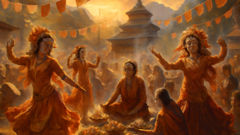
At sunrise, before the first rooster crows, mothers place rice and bananas at the household altar. Farmers pause before the day’s labor to murmur prayers for rain or safety from accident. Even city dwellers, surrounded by modern high-rises and busy streets, light incense to honor the Nats of their ancestors. During important life events—births, weddings, journeys—the Nats are formally invoked to bless or safeguard those involved. In times of illness or misfortune, families may call upon a Nat kadaw, or spirit medium, to consult the Nats for guidance.
But it is during the great Nat festivals that Myanmar’s spiritual traditions come most vividly alive. The most famous of these is the Taungbyone Nat Festival, held each August near Mandalay. For one week, thousands descend upon the village to celebrate the brothers Min Gyi and Min Lay—the Taungbyone Nats—whose story is one of loyalty and sacrifice. The festival is a riot of color: dancers whirl in shimmering costumes, musicians play hypnotic rhythms, and spirit mediums—possessed by the Nats—offer advice and blessings, often speaking in voices not their own. Offerings pile high at every shrine: coconuts, bananas, bottles of rice wine, and mountains of flowers. Pilgrims bring wishes for health, love, or fortune, each hoping to touch the divine.
These rituals are not relics of the past. They adapt to the times, blending Buddhist practice with older animist beliefs. Monks chant alongside drummers; families recite Buddhist prayers even as they present Nat offerings. This syncretism shapes Myanmar’s spiritual landscape, allowing old and new to coexist in harmony. The Nats are not rivals to Buddhism, but partners—guardians who protect both the body and the soul.
Through these living traditions, the people of Myanmar find comfort, connection, and continuity. The Nats remain ever-present: in the laughter of children playing beneath banyan trees, in the solemnity of festivals, in the quiet moments before dawn. Their stories and rituals remind everyone that the world is full of mystery, that every life is touched by forces unseen, and that wisdom often dwells in the spaces between what is known and what is believed.
Conclusion
In the heart of Myanmar, the Nats remain—silent witnesses to history, stewards of wild places, and companions in daily joys and sorrows. Their world is not separate from ours, but woven into every dawn prayer, every village festival, every whispered hope. Through tragedy and triumph, these spirits have shaped the character of a nation that looks to the unseen for wisdom and comfort. In honoring the Nats, people acknowledge the fragile harmony between humanity and nature, past and present, the mortal and the divine. To listen to their stories is to hear the pulse of Myanmar itself: resilient, mysterious, and deeply alive.

